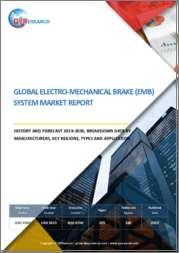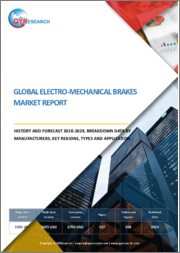
|
시장보고서
상품코드
1775362
세계의 전자제어 제동력 배분 시스템(EBD) 시장 : 예측(2025-2030년)Global Electronic Brake Force Distribution System (EBD) Market - Forecasts from 2025 to 2030 |
||||||
전자제어 제동력 배분 시스템(EBD) 시장은 2025년 39억 1,300만 달러에서 2030년에는 49억 300만 달러로 성장하며, CAGR은 4.62%로 예측됩니다.
세계 자동차 전자식 제동력 배분 시스템(EBD) 시장은 자동차의 안전성 향상과 운전 경험 개선에 대한 수요 증가로 성장하고 있으며, EBD는 잠김 방지 브레이크 시스템(ABS) 및 미끄럼 방지 장치(ESC)의 중요한 하위 시스템으로 노면 상태, 차량 속도, 하중 분배 등의 변수에 따라 각 바퀴에 가해지는 힘을 동적으로 조정하여 제동을 최적화합니다. 하중 분배 등의 변수에 따라 각 바퀴에 가해지는 힘을 동적으로 조정하여 제동을 최적화합니다. 이 기술은 차량의 안정성을 유지하면서 최대 제동력을 확보하여 미끄러짐과 제어 불능의 위험을 줄여주며, 특히 EBD는 제동 중 체중 이동을 보정하고 뒷바퀴에 가해지는 압력을 감소시켜 잠김을 방지하는 데 매우 중요합니다.
기술 개요
EBD는 바퀴 속도 센서, 제동력 어큐뮬레이터, 전자제어장치(ECU)를 통합하여 작동합니다. 바퀴 속도 센서는 각 바퀴의 속도를 모니터링하여 슬립률을 계산하고, 그 데이터를 ECU에 전송합니다. ECU는 각 바퀴에 적절한 제동력을 가하도록 브레이크 포스 어큐뮬레이터에 신호를 보냅니다. 제동력을 점진적으로 가하여 바퀴의 잠김을 방지하는 ABS와 선회시 언더스티어 및 오버스티어를 완화하는 ESC와의 시너지 효과로 차량 전체의 제어성과 안전성을 향상시킵니다. 이러한 통합 안전 시스템에 대한 수요가 EBD 시장 확대의 주요 요인이 되고 있습니다.
목차
제1장 개요
제2장 시장 스냅숏
- 시장 개요
- 시장의 정의
- 조사 범위
- 시장 세분화
제3장 비즈니스 상황
- 시장 성장 촉진요인
- 시장 성장 억제요인
- 시장 기회
- Porter's Five Forces 분석
- 업계 밸류체인 분석
- 정책과 규제
- 전략적 제안
제4장 기술 전망
제5장 세계의 전자제어 제동력 배분 시스템(EBD) 시장 : 컴포넌트별
- 서론
- 하드웨어
- 소프트웨어
제6장 세계의 전자제어 제동력 배분 시스템(EBD) 시장 : 차종별
- 서론
- 승용차
- 소형 상용차
- 대형 상용차
제7장 세계의 전자제어 제동력 배분 시스템(EBD) 시장 : 판매채널별
- 서론
- OEM
- 애프터마켓
제8장 세계의 전자제어 제동력 배분 시스템(EBD) 시장 : 지역별
- 서론
- 북미
- 미국
- 캐나다
- 멕시코
- 남미
- 브라질
- 아르헨티나
- 기타
- 유럽
- 독일
- 프랑스
- 영국
- 스페인
- 기타
- 중동 및 아프리카
- 사우디아라비아
- 이스라엘
- 아랍에미리트
- 기타
- 아시아태평양
- 중국
- 일본
- 한국
- 인도
- 인도네시아
- 태국
- 대만
- 기타
제9장 경쟁 환경과 분석
- 주요 기업과 전략 분석
- 시장 점유율 분석
- 기업인수합병(M&A), 합의, 사업 협력
- 경쟁 대시보드
제10장 기업 개요
- Continental AG
- Robert Bosch GmbH
- ZF Friedrichshafen AG
- Toyota Group
- Brembo N.V.
- Akebono Brake Industry Co., Ltd.
제11장 부록
- 통화
- 전제조건
- 기준연도와 예측연도 타임라인
- 이해관계자에 대한 주요 이점
- 조사 방법
- 약어
The Global Electronic Brake Force Distribution System (EBD) Market is expected to grow from USD 3.913 billion in 2025 to USD 4.903 billion in 2030, at a CAGR of 4.62%.
The global automotive electronic brake force distribution (EBD) market is experiencing growth driven by the increasing demand for enhanced vehicle safety and improved driving experiences. EBD, a critical subsystem of anti-lock braking systems (ABS) and electronic stability control (ESC), optimizes braking by dynamically adjusting the force applied to each wheel based on variables such as road conditions, vehicle speed, and load distribution. This technology ensures maximum stopping power while maintaining vehicle stability, reducing the risk of skidding or loss of control. EBD is particularly vital as it compensates for weight shifts during braking, applying less pressure to the rear wheels to prevent locking, especially since front wheels bear most of the vehicle's weight.
Technical Overview
EBD operates by integrating wheel speed sensors, brake force accumulators, and an electronic control unit (ECU). The wheel speed sensors monitor each wheel's speed and calculate the slip ratio, relaying this data to the ECU. The ECU then signals the brake force accumulators to apply the appropriate braking force to each wheel. This synergy with ABS, which prevents wheel lockup by gradually applying braking force, and ESC, which mitigates understeer or oversteer during turns, enhances overall vehicle control and safety. The demand for such integrated safety systems is a key driver of the EBD market's expansion.
Market Segmentation
The EBD market is segmented by vehicle type, sales channel, and geography:
- Vehicle Type: The market is divided into passenger vehicles, light commercial vehicles, and heavy commercial vehicles. Passenger vehicles dominate the market share due to rising production and consumer demand for safer personal transportation.
- Sales Channel: The market splits into original equipment manufacturers (OEMs) and the aftermarket. OEMs hold a significant share, as most new vehicles are equipped with EBD systems integrated with ABS modules during production.
- Geography: The market is segmented into North America, Europe, Middle East & Africa, Asia-Pacific, and South America. North America leads due to high automobile production, increasing demand for vehicles, and a strong emphasis on safe and convenient driving systems.
Competitive Landscape
The EBD market is highly competitive, with a mix of international, regional, and local players. Key strategies include technological innovation, product development, and strategic investments to strengthen market presence. Companies are focusing on integrating advanced safety features to meet regulatory and consumer demands.
Recent Developments
Notable advancements include Toyota's announcement that all new vehicle variants will feature ABS and EBD as standard safety components, reflecting the industry's shift toward prioritizing safety. Additionally, regulatory bodies like the National Highway Traffic Safety Administration (NHTSA) have pushed for mandatory automatic emergency braking systems, further boosting the adoption of EBD and related technologies.
Conclusion
The global EBD market is poised for continued growth, driven by the critical role of EBD in enhancing vehicle safety and stability. Its integration with ABS and ESC, coupled with increasing regulatory mandates and consumer demand for safer vehicles, positions EBD as a cornerstone of modern automotive safety systems.
Key Benefits of this Report:
- Insightful Analysis: Gain detailed market insights covering major as well as emerging geographical regions, focusing on customer segments, government policies and socio-economic factors, consumer preferences, industry verticals, and other sub-segments.
- Competitive Landscape: Understand the strategic maneuvers employed by key players globally to understand possible market penetration with the correct strategy.
- Market Drivers & Future Trends: Explore the dynamic factors and pivotal market trends and how they will shape future market developments.
- Actionable Recommendations: Utilize the insights to exercise strategic decisions to uncover new business streams and revenues in a dynamic environment.
- Caters to a Wide Audience: Beneficial and cost-effective for startups, research institutions, consultants, SMEs, and large enterprises.
What do businesses use our reports for?
Industry and Market Insights, Opportunity Assessment, Product Demand Forecasting, Market Entry Strategy, Geographical Expansion, Capital Investment Decisions, Regulatory Framework & Implications, New Product Development, Competitive Intelligence
Report Coverage:
- Historical data from 2022 to 2024 & forecast data from 2025 to 2030
- Growth Opportunities, Challenges, Supply Chain Outlook, Regulatory Framework, and Trend Analysis
- Competitive Positioning, Strategies, and Market Share Analysis
- Revenue Growth and Forecast Assessment of segments and regions including countries
- Company Profiling (Strategies, Products, Financial Information, and Key Developments among others.
Segmentation
By Component
- Hardware
- Software
By Vehicle Type
- Passenger Vehicle
- Light Commercial Vehicle
- Heavy Commercial Vehicle
By Sales Channel
- OEMs
- Aftermarket
By Geography
- North America
- USA
- Canada
- Mexico
- South America
- Brazil
- Argentina
- Others
- Europe
- Germany
- France
- United Kingdom
- Spain
- Others
- Middle East and Africa
- Saudi Arabia
- Israel
- UAE
- Others
- Asia Pacific
- China
- Japan
- South Korea
- India
- Indonesia
- Thailand
- Taiwan
- Others
TABLE OF CONTENTS
1. EXECUTIVE SUMMARY
2. MARKET SNAPSHOT
- 2.1. Market Overview
- 2.2. Market Definition
- 2.3. Scope of the Study
- 2.4. Market Segmentation
3. BUSINESS LANDSCAPE
- 3.1. Market Drivers
- 3.2. Market Restraints
- 3.3. Market Opportunities
- 3.4. Porter's Five Forces Analysis
- 3.5. Industry Value Chain Analysis
- 3.6. Policies and Regulations
- 3.7. Strategic Recommendations
4. TECHNOLOGICAL OUTLOOK
5. GLOBAL ELECTRONIC BRAKE FORCE DISTRIBUTION SYSTEM (EBD) MARKET BY COMPONENT
- 5.1. Introduction
- 5.2. Hardware
- 5.3. Software
6. GLOBAL ELECTRONIC BRAKE FORCE DISTRIBUTION SYSTEM (EBD) MARKET BY VEHICLE TYPE
- 6.1. Introduction
- 6.2. Passenger Vehicle
- 6.3. Light Commercial Vehicle
- 6.4. Heavy Commercial Vehicle
7. GLOBAL ELECTRONIC BRAKE FORCE DISTRIBUTION SYSTEM (EBD) MARKET BY SALES CHANNEL
- 7.1. Introduction
- 7.2. OEMs
- 7.3. Aftermarket
8. GLOBAL ELECTRONIC BRAKE FORCE DISTRIBUTION SYSTEM (EBD) MARKET BY GEOGRAPHY
- 8.1. Introduction
- 8.2. North America
- 8.2.1. USA
- 8.2.2. Canada
- 8.2.3. Mexico
- 8.3. South America
- 8.3.1. Brazil
- 8.3.2. Argentina
- 8.3.3. Others
- 8.4. Europe
- 8.4.1. Germany
- 8.4.2. France
- 8.4.3. United Kingdom
- 8.4.4. Spain
- 8.4.5. Others
- 8.5. Middle East & Africa
- 8.5.1. Saudi Arabia
- 8.5.2. Israel
- 8.5.3. UAE
- 8.5.4. Others
- 8.6. Asia Pacific
- 8.6.1. China
- 8.6.2. Japan
- 8.6.3. South Korea
- 8.6.4. India
- 8.6.5. Indonesia
- 8.6.6. Thailand
- 8.6.7. Taiwan
- 8.6.8. Others
9. COMPETITIVE ENVIRONMENT AND ANALYSIS
- 9.1. Major Players and Strategy Analysis
- 9.2. Market Share Analysis
- 9.3. Mergers, Acquisitions, Agreements, and Collaborations
- 9.4. Competitive Dashboard
10. COMPANY PROFILES
- 10.1. Continental AG
- 10.2. Robert Bosch GmbH
- 10.3. ZF Friedrichshafen AG
- 10.4. Toyota Group
- 10.5. Brembo N.V.
- 10.6. Akebono Brake Industry Co., Ltd.
11. APPENDIX
- 11.1. Currency
- 11.2. Assumptions
- 11.3. Base and Forecast Years Timeline
- 11.4. Key benefits for the stakeholders
- 11.5. Research Methodology
- 11.6. Abbreviations

















